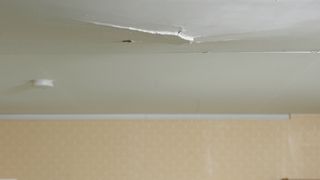Cracks in ceilings: When to worry and when to relax
When ceiling cracks appear in an old or original ceiling, is it serious or superficial? Chartered surveyor Ian Rock explains when to call in the experts

There’s something about cracks in ceilings that can be particularly unnerving. Even the smallest fissures appearing above our heads can fuel suspicions that heavyweight chunks of plaster are poised to come raining down and inflict serious injury — andrepairing old ceilingscan be a daunting task.
But, although cracking may in some cases be a symptom of serious structural problems, more often than not it’s simply a sign of the building ageing rather than a portend of imminent collapse. So how can you tell whether your ceiling is just getting a bit ‘past it’, or is desperately trying to warn you that something ominous is lurking behind the scenes?
Here, we look at when to call in the professionals and when to breathe a sigh of relief.
What causes cracks in ceilings?
The most common type of ceiling cracks are the hairline fractures that appear at joints between sheets of plasterboard, typically fairly straight and less than about 0.2mm wide. The cause is often down to poor quality construction where the joints weren’t properly filled and taped prior to plastering. Such problems can be exacerbated by movement within the underlying ceiling or floor structure, or settlement elsewhere in the building. All buildings move, and because joints between materials are a potential weak point, any related stresses will tend to make an appearance unless disguised by tapes or coving etc.
Traditionallath and plaster ceilings(mostly pre 1930s) are not as robust as modern plasterboard and are less able to accommodate movement or water leakage, potentially allowing thick sections of plaster to loosen and ultimately drop off. Older properties are also more susceptible to seasonal changes in ground conditions and temperatures. So where rigid modern gypsum plasters have been applied to aged ceilings the resulting tensions between timbers and plasterwork can cause localised cracking. Thin horizontal cracks appearing at ceiling edges may similarly be down to different rates of expansion and contraction between masonry walls and timber ceiling joists.
Water leakage from overflowing showers, baths and leaky pipes is a common cause. Water usually finds its way through any lighting points and along joints, leaving a distinctive light brown staining, often exposing the strips of tape between sheets of plasterboard.

Are the cracks in your ceiling a serious problem?
One of the most worrying scenarios is where cracking is caused by dangerous unsupported loadings balanced precariously above ceilings. This typically occurs where botched structural alterations have been carried out, such as DIY removals of chimney breasts or load-bearing walls. Cracking here will normally be fairly localised with associated unevenness and bulging. If this is suspected you need to urgently check if there is anything suspicious located directly above the ceiling and seek professional advice, which in most cases would be astructural engineer.
Broader ‘structural’ causes such as settlement at foundation level will likely result in pathways of associated cracking appearing in nearby walls, typically with significantly wider cracks forming around the edges of ceilings (unless obscured by coving). Horizontal cracking along the tops of bedroom walls where they meet the ceilings could also be a symptom of movement in the roof structure.
When it comes to historic lath and plaster ceilings, surveyors and builders are sometimes accused of being unduly alarmist. This is because the fine strips of wooden ‘laths’ that make up the structure of these ceilings can sometimes come loose from the joists they’re nailed to, as a result of movement or vibration in the floors above or because of water leakage. This can cause the plasterwork to lose its ‘key’ and drop away in chunks.
But condemning all older ceilings on the basis of such potential risks can be misleading. Where it is suspected sections of old plasterwork may have broken away, a simple way to assess their firmness is by tapping them and listening to see if they sound hollow. Any loose laths should be checked for timber decay, and any defective areas isolated before carrying out localised repair or replacement work.
Who can diagnose structural cracks?
Chartered surveyors carrying out building surveys for home-buying clients routinely flag up the presence of ceiling cracks. If remedial work is required, this is normally explained in the report with a red or amber ‘condition rating’ indicating the level of seriousness. But as an existing homeowner, if you notice fresh cracks appearing it’s probably worth instructing a structural engineer to focus on the specific issue rather than paying forhouse surveyssuch as a ‘whole house survey’. See www.structural-surveys.co.uk.
Either way, diagnosing the true causes of cracking can often call for methodical detective work, starting with an assessment of the age, materials and location of
the ceiling. Checking the size and condition of the joists that form the ceiling structure is obviously fundamental, as is looking for any alterations or unusual loadings, along with possible environmental issues such as excessive heat or moisture.
Any movement elsewhere in the building needs to be investigated and appropriate solutions devised. The cost of an average RICS Homebuyer Survey might be around the £450 mark, with a slightly lower fee for a structural engineer’s report to diagnose specific cracking.
How are cracked ceilings fixed?
This largely depends on thetypes of ceilingyou are dealing with. Modern plasterboard ceilings are surprisingly durable and in most cases can accommodate water leakage or localised movement without major trauma. Bowed or damaged areas can simply be cut out and patched with new sheets of plasterboard before filling and taping the joints, then plastering to match the surrounding surfaces. Hairline cracks between boards may only need localised decorative attention with flexible filler and emulsion, although in some cases, all the joints between boards and room edges will need to be scrim taped and filled before a fresh coat of ceiling plaster is applied.
Cracking linked to different rates of thermal expansion between adjacent materials at ceiling edges, and which is not structurally significant, can often simply be concealed with coving fitted between the walls and ceilings.
More serious repair work is likely to be required with historic lath and plaster ceilings. Once any loose or damaged areas have been isolated they can be cut out and either infilled with plasterboard or reconstructed by securing or replacing loose laths before replastering. For added strength, lining paper can be applied over the surface to match the surrounding original ceilings. If extensive areas of old plasterwork have come loose then you may need to replace the whole ceiling with new plasterboard, unless the building is listed or of special historic value, in which case like-for-like replacement will be needed.
Repairs to cracking caused by structural issues elsewhere in the house will obviously have to wait until the root causes have been addressed. For example, where the rafters have pushed roof slopes outward, remedial repairs will first be needed to restrain the rafters prior to replastering
Does home insurance cover ceiling cracks?
如果损害是由一个主要的突然和unexpected’ event such as subsidence, fire or escape of water from burst pipes or overflowing tanks then you should be able to claim on your buildings insurance policy. With smaller defects, where repair work is relatively low cost, the fact that insurers generally impose quite high policy excesses can be a deterrent to submitting claims. Where the cause of cracking is deemed to be down to ‘wear and tear’ or ‘gradual damage’ insurers will generally decline claims to cover the cost of works.

Chartered surveyor Ian Rock FRICS is the author of the Loft Conversion Manual and is founder of www.rightsruvey.co.uk
Get the Homebuilding & Renovating Newsletter
Bring your dream home to life with expert advice, how-to guides and design inspiration, direct to your inbox.
Chartered surveyor Ian Rock MRICS is a director isRightsurvey.co.ukand the author of eight popular Haynes House Manuals, including theHome Extension Manual,Self Build ManualandPeriod Property Manual.
伊恩也Zennor咨询公司的创始人。在addition to providing house surveys, Zennor Consultants provide professional guidance on property refurbishment and maintenance as well as advising on the design and construction of home extensions and loft conversions, including planning and Building Regulations compliance.
Ian has recently added a 100m2 extension to his home; he designed and project managed the build and completed much of the interior fit-out on a DIY basis.
Bring your dream home to life with expert advice, how-to guides and design inspiration, direct to your inbox.
Thank you for signing up to Homebuilding. You will receive a verification email shortly.
There was a problem. Please refresh the page and try again.
